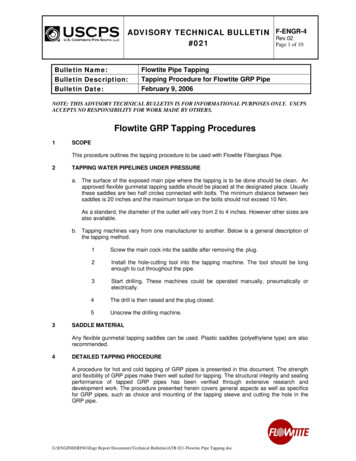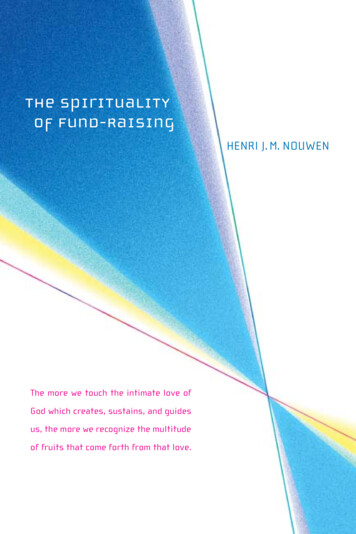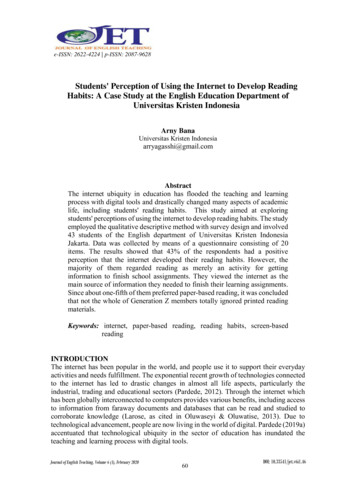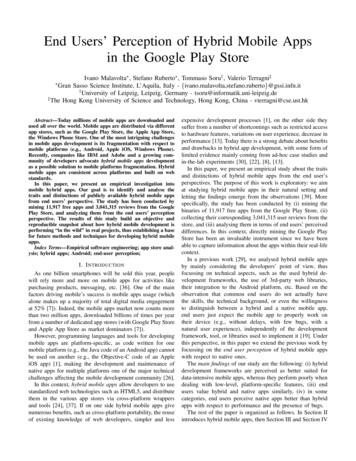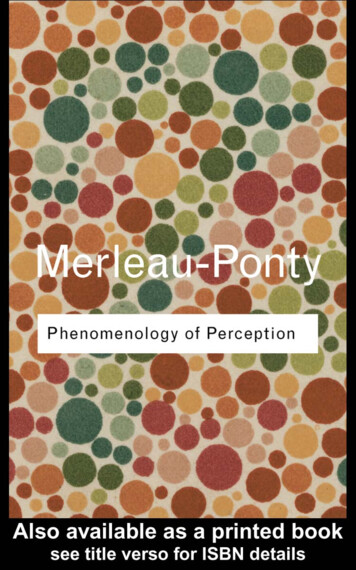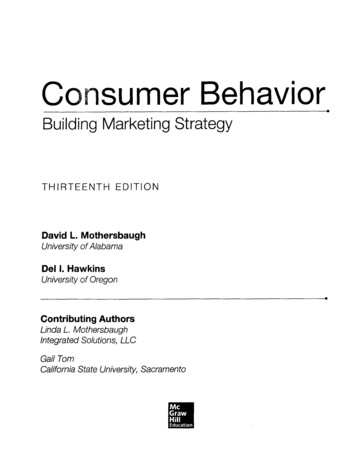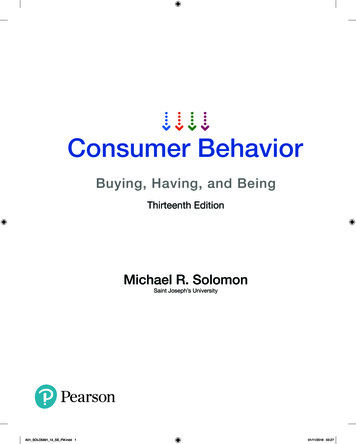
Transcription
Consumer Perceptionof the Value ofBrand HeritageBACHELOR THESIS WITHIN TUTOR: DerickC.LördeJÖNKÖPING May2017
ACKNOWLEDGEMENTThe authors have during the last semester of their three-year bachelor’s degree program inbusiness administration taken the opportunity to conduct a study about a topic of particularinterest to them. Accordingly they chose to explore how consumers perceive the value of brandheritage of luxury fashion brands.The authors would like to express their gratitude towards all the individuals they havecollaborated with during the process of writing this thesis. Without their contribution it would nothave been possible to conduct this study. First of all, the authors would like to thank the tutorDerick C. Lörde for his continuous feedback and support throughout the writing process. Also,the authors would like to thank all respondents participating in the interviews for their valuableresponse and refection, enabling the fulfilment of the purpose of the study.Jönköping,May21,2017EmmaLarssonElinNorell2
nsumer Perception of the Value of Brand HeritageAuthors:Emma LarssonElin NorellTutor:Derick C. LördeDate:2017-05-21Subject terms:Brand Heritage, Consumer Perceived Value, Consumer PerceivedValue of Brand Heritage, Luxury fashion brands.ABSTRACTBrand heritage and consumer perceived value are two concepts which separately have received agrowing interest among academics for quite some time. However both of them combined, henceconsumers’ perception of the value of brand heritage is a relatively unexplored field of research.This study therefore intends to explore how consumers perceive the value of brand heritage ofluxury fashion brands. To achieve this purpose, the study will investigate consumers’ perceptionof the value of brand heritage of four European luxury fashion brands – Burberry, Chanel, Gucci,and Louis Vuitton – which serve as illustrative/reference brands in this study. These fourEuropean luxury fashion brands are chosen as illustrative brands in this study based on thedetermination that heritage is a central part of their brands.Secondary data was collected through Internet based document analysis of the illustrative brandsto determine whether these qualify as heritage brands. Furthermore, semi-structured interviewswere conducted to collect primary data for the purpose to explore how consumers perceive thevalue of brand heritage of the illustrative brands.The findings of the study reveal that consumers perceive the value of the brand heritage of theillustrative brands because it serves as a source of credibility and trust between the consumersand the brands. There is a perception that the brands have managed to maintain a certain standardregarding quality and craftsmanship, and likewise delivered according to consumers’expectations over time. Furthermore consumers perceive the value of the brand heritage of theillustrative brands since it contributes to a sense of belongingness and social acceptance. Theyvalue the identity and meaning of the illustrative brand, hence the perception that the brands havemanaged to persistently deliver according to their core values and promises over time. It providesthe consumers with the opportunity to connect with the brands on a personal level and to createtheir own individual identities and lifestyles through the brands. All this, in combination with theperception of the brands as timeless and durable, that they inhabit a sense of credibility and trust,which in the long run may generate loyalty - they value that the brands are loyal to them conclude how consumers perceive the value of the brand heritage of the illustrative brands.
RY&META- CEIVEDVALUEOFBRANDHERITAGE172.4.CONSUMER- ANDLOYALTY202.5.CHOICEOFTHEORIES213.METHODOLOGY224
ESTUDY607.1.IMPLICATIONSFORTHEORY605
2.SWEDISH739.1.3.STATISTICALDIAGRAM806
1. alsobepresented.1.1. BACKGROUND“Make a better future by developing elements of the past”(Goethe - German poet and writer; Menkes, 2010)Research about "heritage brands" or "brands with heritage" have received considerable attentionover the years (Balmer & Burghausen, 2015; Urde et al. 2007; Wuestefeld et al., 2012).Literature suggests that heritage is a main driver of brand value and equity (Wiedmann et al.,2011). This might be explained partly due to the fact that heritage invokes a sense of credibilityand authenticity about the brand as perceived by consumers. The past highlights essentialqualities of the brand such as core values, conduct, and quality, contributing to perceivedcredibility and reliability which in turn might enhance the value of the brand and contribute topresent and future performances (Urde et al., 2007).The literature suggests that the perception consumers have about a brand is a main driver for itsvalue or equity. Brand equity has thus been referred to as consumer-based brand equity, whichstresses the importance of consumers’ attitudes, and behaviour for enhanced brand value basedon their brand awareness, brand association, perceived quality and brand loyalty (Aaker, 1991).Accordingly the past, hence a brand's historical background and track record, has thus beenassumed to influence how consumers perceive the brand and what they associate with it today(Wiedmann et al., 2011).Primarily formulated by the German poet Goethe and currently quoted by Karl Lagerfeld, CEOand head designer of the luxury fashion house Chanel, the phrase “Make a better future bydeveloping elements of the past” is referred to as one of Chanel’s inspiring principles andleitmotifs (Menkes, 2010). Similarly the former CEO of the fashion house Hermès, Jean-LouisDumas, emphasise the impact heritage can have on a brand's current performance by saying that“time is our greatest weapon” arguably referring to the importance of accepting, preserving andusing the history and legacy of such a luxury fashion house to enrich the value of its brand (Ricca7
& Robins, 2012).The consumption of luxury fashion brands has expanded enormously on a global level over thelast twenty years (The Economist, 2014; Hennings et al., 2015). Even though the industry ofluxury fashion, just like other markets, occasionally experience ups and downs, it has beenargued that luxury brands are among the ones who suffered the least from the economic crisis in2008. They were quick to recover arguably based on the general assumption that luxury brandshave evolved over time into well-founded establishments, where knowledge, purpose andtimelessness of their businesses provide them with valuable leverage, the possibility to resistexternal pressure, and preserve their legacy (Ricca & Robins, 2012).The consumption of luxury brands is no longer only available for an exclusive segment of thesociety and therefore the number of consumers belonging to the luxury fashion industry'sconsumer base has increased (Menkes, 2002). As a result luxury fashion brands have witnessed asteady growth in their collective brand value (Robins, 2016). Within the luxury fashion industryEuropean brands are those who are contributing to the increase in collective brand value the most(Brujo, 2017; Statista, 2017). This might be due to the fact that Europe, with its remarkableinherited and preserved heritage, is serving as the home for many of the most superior luxuryfashion houses (King, 2016).Meta-luxury is a new term use to describe and assess the essence of true luxury. Meta-luxuryacknowledges the importance of knowledge, purpose, and timelessness as principal componentsof a brand in order to achieve something extraordinary and unique, namely luxury (Ricca &Robins, 2012). Moreover, it has been proclaimed that a majority of those luxury brands, whichare considered meta-luxury brands, are based in Europe. Even though the new definition ofluxury has acknowledged that the history of such brands is highly essential for their existence,endurance and sustainability, the relationship between heritage and luxury brands has beenemphasised long before. There is a general assumption that the majority of the most luxurybrands of today, those arguably qualifying as meta-luxury brands, are marked by their notablepast and historical roots. The belief is that a strong heritage establishes the soul and heart of aluxury brand, its core values, skills, excellence and quality (Wuestefeld et al., 2012; Jacksson &Haid, 2002). In turn heritage might thus be considered a contributor to the creation of brand valueand influence how consumers perceive the value of such luxury brands.8
1.2. PROBLEMPrevious research argues that brand heritage influences consumers’ perception about a brand,their attitude towards it and how they behave accordingly (Wiedmann et al., 2011). Additionally,there is an assumption that consumer perception, attitude and behaviour towards a brandcontribute to its enhanced value (American Marketing Association, 2017, Aaker, 1991; Keller,1993).A majority of the most influential luxury fashion brands are located in Europe today. It has beenargued that they are characterised by their past and marked by their historical roots whichhighlight the importance to acknowledge heritage as part of their being (Brujo, 2017). Somebrands qualify as heritage brands, meaning that they inhabit certain characteristics measured anddetermined according to a model proposed by Urde et al., (2008).However, how consumers perceive the value of brand heritage of luxury fashion brands,qualifying as heritage brands, is a topic that has not previously been researched and thereforeconstitutes a literature gap. Consequently the intention with this study is to contribute to existingliterature by filling the identified gap where there is a lack in previous research about howconsumers perceive the value of brand heritage of luxury fashion brands. This study argues that itis important to address this gap in the literature because it will add new understandings andknowledge to be used theoretically to enable further research and practically for instance bybrand managers.1.3. PURPOSEThe purpose of this study is to explore how consumers perceive the value of brand heritage.To achieve this purpose, the study will investigate consumers’ perception of the value of brandheritage of four European luxury fashion brands – Burberry, Chanel, Gucci, and Louis Vuitton –which serve as illustrative/reference brands in this study. These four European luxury fashionbrands are chosen as illustrative brands in this study based on the determination that heritage is acentral part of their brands.9
1.4. RESEARCH QUESTIONHow do consumers perceive the value of brand heritage as a component of luxury fashion brands,illustrated by Burberry, Chanel, Gucci, and Louis Vuitton?1.5. METHODThis paper will be conducted by use of two data collection methods of a qualitative nature. Thetwo methods correspond to a collection of both secondary data and primary data. ThroughInternet based document analysis of the illustrative brands, secondary data will be collected todetermine whether these qualify as heritage brands with reference to the Heritage Quotient (HQ)framework (Urde et al., 2007). Additionally primary data from semi-structured interviews will becollected in order to explore how consumers perceive the value of the brand heritage of theillustrative brands. The interviewer will conduct the interviews based on an interview guide withpredetermined questions related to the research purpose and the theoretical framework of thestudy.1.6. CONTRIBUTIONSThe main contribution of this paper is to add new understandings and knowledge about the valueof brand heritage to existing literature. Secondly, previous research about brand heritage hasusually taken an organisational approach by focusing on the identity of the brand and theorganisation in question; who they are, what they represent, and how they portray themselves tothe outside world. Therefore, this study intends to make a theoretical contribution to literature byfocusing on consumers and how they perceive the brand heritage of a brand or organization.Finally, the authors want to fill the identified literature gap and therefore make a practicalcontribution as it might help brand managers of luxury fashion brands, which qualify as heritagebrands, in their overall assessment and understanding about how consumers perceive and value
of the value of brand heritage of four European luxury fashion brands – Burberry, Chanel, Gucci, and Louis Vuitton – which serve as illustrative/reference brands in this study. These four European luxury fashion brands are chosen as illustrative brands in this study based on the determination that heritage is a central part of their brands. Secondary data was collected through Internet .
